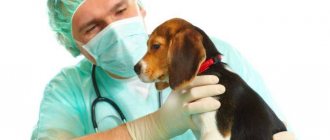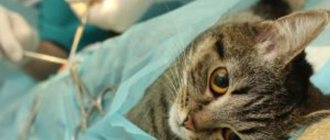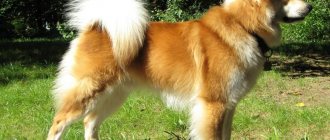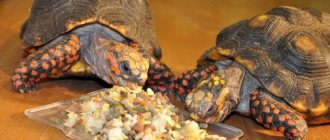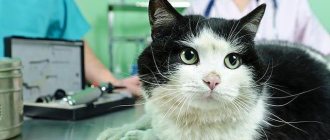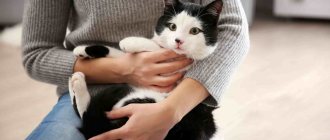At what age is surgery performed?
There is a misconception that male dogs are castrated and females are spayed. In fact, both types of surgery are available for dogs of both sexes. The first type involves removing the testes or uterus and ovaries, the second involves ligating the fallopian tubes or spermatic cords.
A huge disadvantage of sterilization is that the dog’s desire does not disappear and all manifestations of sexual behavior are preserved. Castration brings peace not only to the owner, but also to the animal itself.
Expert opinion
Anna Abramenko
An avid dog lover. Experience in veterinary medicine since 2009.
Ask a Question
Castration or sterilization too early can lead to unpredictable consequences, including problems with the genitourinary system
The right time for the operation is the first thing that owners think about. The best moment is considered to be the beginning of puberty. The dog’s sexual instinct has not yet fully formed; it does not mark its territory. At the same time, the development of the body is coming to an end, the operation will not harm it.
It is better to castrate males at 7-8 months. This applies to small dogs. For large breeds, a period of 1-1.5 years is optimal. It is customary to operate on female dogs before their first heat, at the age of 6-9 months.
Castration and sterilization are also acceptable for adults. But you need to take into account that their health is no longer as strong as that of puppies, so the risk of complications increases, the stitches take a long time to heal, and the dog’s rehabilitation process is delayed.
This is interesting: What is the difference between castration and sterilization
In older, uncastrated animals, the risk of cancer increases. If the dog is not operated on in time, it is worth doing it before aging begins. When a bitch is used for breeding, her last birth should not be later than 6 years. Afterwards, the pet can be neutered.
About dog sterilization
Sterilization of dogs is an operation to remove internal reproductive organs - the uterus and ovaries. It is more correct to say castration (ovariohysterectomy) in relation to both males and females. But owners are more accustomed to separating these two concepts.
It is recommended to perform the operation before the first heat at the age of six to seven months, this reduces the risk of developing mammary tumors in the future. But in general there are no age restrictions . You need to focus on existing or absent diseases. Read a detailed article on the topic: “Dog sterilization – features, types and nuances of the procedure.”
There are different methods of sterilization:
- Through the white line . Classic way. The incision is made just below the navel.
- Lateral access . In this case, the surgical field will be located on the side. This approach is most often used in large and giant breed bitches to minimize the risk of postoperative hernia.
- Laparoscopic sterilization . It is carried out using a special device - an endoscope. Minimal invasiveness. The operation is performed through 2-3 punctures on the abdominal wall. But such sterilization costs about twice as much as classical sterilization.
- Removal of only the ovaries. Some surgeons leave the uterus and remove only the ovaries to minimize surgical access in young female dogs without pathologies.
- Removal of the uterus and ovaries. More often, to avoid problems, complete resection of the internal genital organs is recommended.
Which method to choose depends on the wishes of the owner and the recommendations of the surgeon. Be sure to discuss this issue before surgery. It is also worth asking your doctor whether additional diagnostics are needed in the form of blood tests and ultrasound of the heart to find out the degree of anesthetic risk, since the operation is performed under general anesthesia.
Possible complications during anesthesia
Many operations on dogs use anesthesia. It is necessary for pain relief and immobilization of the animal. During its action, a number of complications may arise. This is due to the effect of anesthesia on the centers of the brain.
The most common are:
- breathing problems: slowing, obstruction, hypoxia, bronchiole spasm, pulmonary edema;
- cardiac disorders: bradycardia, tachycardia, arrhythmia, ventricular fibrillation, cardiac arrest;
- decrease in body temperature;
- allergic reactions;
- vomiting, regurgitation (reversal) of stomach contents;
- delayed awakening.
Complications most often occur for several reasons:
- insufficient preoperative examination;
- incorrect choice of method or drug for anesthesia;
- drug intolerance;
- errors in calculating the administered anesthesia.
Expert opinion
Anna Abramenko
An avid dog lover. Experience in veterinary medicine since 2009.
Ask a Question
To avoid dangerous situations, the owner must carefully select a clinic and specialist.
Fortunately, in pets without chronic pathologies, surgery usually proceeds without complications. Castration lasts 10-15 minutes for males and 30-60 for females. The awakening time takes from 2-3 hours to a day (by this time the dog finally comes to his senses).
How long a pet recovers from anesthesia depends on the type and method of administration of anesthesia, as well as on the individual characteristics of each animal.
Dog behavior in the first 5 days after recovery from anesthesia
Now let’s look at the process of a pet recovering from anesthesia day by day. Since five days are the most critical, it is necessary to focus on them.
| Time interval | Features of the behavior of a dog recovering from the effects of anesthesia |
| First day | At this time, the pet is just waking up. The animal's behavior is noticeably inhibited, the dog is lethargic and apathetic. The pet begins to eat towards the end of the first day, but food should be given little by little. You can’t limit her drinking. |
| Second day | If the animal is young enough, then by this time its condition will almost completely return to normal. Food is given up to five times a day, but in small portions. As in the previous case, the animal is not limited in drinking in any way. In some cases, the pet still exhibits stiffness and uncertainty in its movements. |
| Third day | In most cases, by this time the dog has fully recovered and its appetite has returned to normal. The portions can be increased a little, but still during this period it is better to feed the pet more often, but in smaller portions. If everything is fine with the animal, you can go for short walks. |
| Fourth day | At this time, the animal still needs to be supervised, but in most cases the dog fully recovers. You can already walk with her, but no more than 15 minutes at a time. The pet should not run or jump yet. By the end of the fourth day, the dog is gradually transferred to its usual diet. |
| Fifth day | The animal is transferred to a normal diet and maintenance. On the fifth day, it is also advisable to take your pet to the veterinarian to check the condition of the stitches. |
Shipping
Expert opinion
Anna Abramenko
An avid dog lover. Experience in veterinary medicine since 2009.
Ask a Question
The trip should be carried out as carefully as possible, sudden movements, shaking, and collisions with uneven roads should be avoided.
You need to start caring for your dog immediately after surgery. The primary goal is to get your pet home without any unpleasant consequences. Even if he woke up in the clinic, you shouldn’t lead him on a leash. The dog still doesn’t have enough strength for this.
If the pet is small, you can carry it home in your arms; if it is large, you need to find transport.
When transporting an animal, you need to cover it with a warm blanket, since anesthesia slows down all processes in the body and lowers the temperature. In addition, involuntary urination is possible, so it is better to place a disposable diaper under the dog.
There is no need to object when the veterinarian advises leaving the animal under observation overnight. This happens if the pet experiences severe discomfort, painkillers do not help him, he is too lethargic and weak.
At a veterinary clinic, a doctor will be able to monitor the dog’s condition and, if necessary, provide specialized assistance.
Specifics of the problem
If natural needs are not fully satisfied, the animal will experience discomfort. At the same time, if you do not plan to burden yourself with caring for the kids, then try not to let the dog go far from you during a walk during the period of heat. The male will have to be constantly monitored, especially if there are females walking nearby. Having bred your pet once, you will have to constantly look for partners for it or sterilize it.
After sterilization, the dog’s behavior becomes calmer and more measured. He doesn't break the leash during walks and plays with a ball like a puppy.
First day
When arriving home, the pet requires increased attention, especially in the first 24 hours. After recovering from anesthesia, he has poor spatial orientation and cannot always get up to go to the toilet. If your dog whines, it means he is in pain, you should give him a painkiller tablet.
Expert opinion
Anna Abramenko
An avid dog lover. Experience in veterinary medicine since 2009.
Ask a Question
It is prohibited to use a heating pad; it can cause internal bleeding.
It is better to place the animal on the floor, because it can easily fall from the sofa or other surfaces due to lack of coordination. A place should be chosen without drafts and away from heating devices. To prevent your pet from freezing, you should lay a bed or blanket on the floor.
Until the dog finally wakes up, she will urinate on herself. You can’t scold her for this, you just need to put an absorbent diaper on the sunbed and don’t forget to change it as needed. Once every half hour, the animal should change the side on which it lies.
The first day after surgery the pet is inactive and sleeps a lot. You should provide him with maximum peace, keep small children and pets away. Every 30 minutes you need to monitor your breathing, pulse, and the condition of your mucous membranes.
To avoid dryness and pain in the eyes, you can use special drops. If your pet does not drink on its own, you should give it water from a syringe without a needle.
The first day for a dog after castration is the most difficult and, in many ways, decisive. The owner must provide her with maximum support and care and, if possible, always be nearby.
Postoperative care
Caring for your dog after spaying and neutering includes a number of recommendations and tips. Following these guidelines will help the pet avoid complications and rehabilitate as soon as possible. There is no need to rely on the animal to cope on its own; it needs human help.
The first day: how to behave and whether to disturb your pet
Once you are allowed to approach the animal and take it home, try to surround it with warmth - literally. The fact is that after sterilization, all functions of the dog’s body slow down and this cannot but affect the blood flow - the pet can freeze even if it’s summer outside, and the clinic premises are not so cold. Therefore, transportation should be carried out in a special box, which will contain everything you need - a warming bedding and a blanket. They need to shelter the animal.
Staying in the same position for a long time can lead to muscle pain. To prevent this from happening, place the dog on a flat surface. It is advisable that it is not hard and cold - instead of the usual lounger, you can put a thick mattress. Be sure to cover the animal with something warm - the same blanket or other fabric that will prevent hypothermia.
Do not forget that after sterilization your pet cannot be kept:
- in a draft;
- near a hot battery;
- on a sofa, chair or bed.
It is forbidden to place a heating pad on a recovering animal - this can lead to serious complications. Most often, such carelessness leads to the onset of internal bleeding.
While under the influence of anesthesia, the dog cannot control itself and may urinate. If appropriate measures are not taken, its fur will become wet and the animal will soon freeze. Therefore, the owner will need special absorbent bedding or napkins - they can be placed under the pet’s body, but they must be changed in a timely manner.
It is also necessary to shift the dog from one side to the other from time to time. Sleeping in the same uncomfortable position can cause numbness in the paws and swelling of the lungs.
All you need to do during the period after anesthesia is to monitor the animal and make sure that it is warm and comfortable. You can and even need to check your heart rate - the pulse should be smooth and clear, and your breathing should be calm. A sign of gradual normalization of the condition is the reaction to external stimuli. If your pet twitches an ear or moves its paw slightly in response to a light tickle, everything is fine and there is nothing to worry about. But the absence of such a signal means that you need to wait a few more hours to get out of sleep.
How to care for a dog after sterilization: when the anesthesia wears off
Often, owners are afraid of deterioration precisely in the postoperative period, which occurs on the second day after the procedure. If the animal’s condition changes, it is necessary, without wasting time, to contact a veterinary clinic, where specialists will be able to provide assistance to the pet.
In some cases, after anesthesia, signs may appear indicating disturbances in the respiratory function and functioning of the cardiovascular system:
- The dog is choking, gasping for air with its mouth open.
- Characterized by uneven breathing with wheezing.
- Body temperature rises (the difference from the norm is significant - more than 1 degree).
However, do not be alarmed if you notice the following symptoms in your dog:
- Change in color of the mucous membrane - very pale or with a bluish tint.
- Mild shaking, which usually goes away quickly.
- A slight decrease or increase in body temperature.
The owner may also be frightened by the state of the animal after recovery from anesthesia - the dog may stagger, it steps incorrectly and looks weakened and exhausted. The following characteristic behavioral features are also possible:
- freezing in one position for several seconds;
- slow reaction to the owner’s voice or its absence;
- fear turning into panic;
- aggression towards family.
An animal can crawl under the sofa, hide in the darkest corner, knock down all the corners, or look at its owner in disbelief. Don’t be scared and take your pet to the doctor - these are just features of the rehabilitation period. You need to be patient and wait: soon the reflexes will be restored, and your dog will again behave as before - cuddle up to you and enthusiastically respond to your invitations to play or go for a walk.
In the meantime, try not to irritate or disturb your pet - sit next to it so that it is not frightened by your presence, talk to it in a quiet, calm voice and caress it, but do not force it to make contact if the animal does not want it. Everything has its time. Let your four-legged friend rest and sleep more - after surgery it is important to gain strength.
Seam processing
During the postoperative period, you need to carefully monitor your pet's suture. When castration and sterilization of bitches, a fairly large incision is made, so problems arise with it and swelling and swelling of the suture often appears.
The process of restoring a male dog in this part is easier. Their surgical wound is small. Due to the accumulation of lymph, swelling of the scrotum may occur within 5-7 days, but this is the norm, a protective reaction of the body.
Expert opinion
Anna Abramenko
An avid dog lover. Experience in veterinary medicine since 2009.
Ask a Question
To prevent the dog from licking the seam, it is better to put a special bandage on it and make sure that the pet does not remove it and chew it.
As a rule, veterinarians remove stitches at 10-14 days, in some cases earlier. At this time, the owner is required to regularly treat the dog’s stitches. The doctor operating on the pet should tell you how to do it correctly.
The procedure does not cause any discomfort to the animal. On the contrary, it relieves the itching and tightness of the skin that appears during wound healing. The treatment is carried out with any antiseptic, softening the crusts. It is important that it does not contain alcohol. Hydrogen peroxide is best.
You also need to remove all dirt around the wound, then blot it dry. After this, the seam is lubricated with Levomekol ointment or other healing and anti-inflammatory agent. If the situation is favorable, after a few days it becomes dry, the surrounding skin has no redness, and the swelling gradually subsides.
The wound healing process does not always go smoothly. The reason that the suture does not heal for a long time is infection or rejection of the material.
The owner should be alert to the following signs:
- discharge from the wound, especially containing pus, blood, separation of its edges;
- the treatment procedure causes pain to the dog;
- swelling that does not subside within several days;
- hot skin;
- unpleasant smell.
Expert opinion
Anna Abramenko
An avid dog lover. Experience in veterinary medicine since 2009.
Ask a Question
In these cases, consultation with a veterinarian is required. There is a high probability that the pet will need wound treatment under anesthesia and re-suturing.
Nutrition
Changing your diet is an important part of your dog's recovery after surgery. For the first 24 hours, the animal does not need food, just clean drinking water is enough. Due to a weak swallowing reflex, food can enter the bronchi, leading to lack of oxygen and death.
The next day after surgery, the dog begins to be given food in liquid or pureed form (for example, fermented milk drinks, vegetable puree, poultry broth). It should not cause alarm if the pet at first eats less than usual and is picky.
After castration and sterilization of an animal, its nutrition necessarily changes. Dogs that have no interest in hunting find joy in food and consequently gain weight quickly. You should not allow your pet to become obese.
You need to remove high-calorie foods from your diet, reduce the number of meals and portion sizes. A convenient option for the owner is to feed the sterilized dog with special food.
What to do if your dog won't let you approach him
After anesthesia, a dog may behave inappropriately and may begin to hallucinate. She may not recognize the owner, not allow anyone to approach her, or behave aggressively. In such cases, doctors advise not to panic, you just need to wait for time, calmly observing her, and help her calm down. This behavior will go away as the anesthesia leaves the body.
Sad pet
Features of skin and coat care
After surgery, you need to regularly examine your pet's fur and skin. Particular attention is paid to the seam area. It should always be clean to avoid infection of the wound.
You can apply a sterile bandage to it.
The coat of most breeds does not change its structure or condition after castration, so it does not require special care. It is not recommended to use any products until the seam has completely healed. You should also not wash your pet until rehabilitation is complete.
What is not normal? There are several reasons to worry about your animal:
- Continuous shaking and convulsions;
- The heart beats too fast or too slow;
- Uneven, rapid breathing, wheezing.
The doctor should explain what is normal, but if you are concerned about the animal’s condition, you should immediately contact a veterinarian. Having woken up from anesthesia, the dog will try to get to its feet, stagger, try to walk, and often the pet may vomit, all this is normal, but this part of the rehabilitation requires special attention. The pet is disoriented and at this time may become injured, not respond to the owner or react inappropriately, get scared, or become aggressive. It is worth showing understanding and trying to surround the dog with calm, give it some more rest, carefully monitor and secure the environment around it so that the pet does not get stuck anywhere or fall from a height. You cannot feed or water the dog at this time; you can give it water when it is stable on its feet and moving around.
Complications
Despite the fact that castration is not considered one of the most difficult operations, a number of complications can still arise after it. To minimize this risk, you must take into account the recommendations and advice of your veterinarian.
The following problems often arise:
- Sometimes in the first days the pet becomes constipated. In this case, you need to reconsider his diet. It should only contain liquid food.
- Lack or decreased appetite. For the first 2-3 days this is normal, but then it requires the help of a veterinarian.
- Drowsiness and weakness.
- Poor orientation on the ground, especially on the first day.
These symptoms usually go away on their own. But there are signs that indicate the presence of serious problems and require contacting a clinic:
- suppuration, suture rupture;
- elevated temperature;
- pain when walking;
- urinary incontinence;
- hernia;
- tumor in the operated area;
- cyanosis of tissues (a sign of dangerous intra-abdominal bleeding).
Expert opinion
Anna Abramenko
An avid dog lover. Experience in veterinary medicine since 2009.
Ask a Question
In order not to further disturb the dog or aggravate its situation, a specialist can be called to your home.
Veterinarian advice
In order for your pet’s rehabilitation to go without complications, it is a good idea to consider the following recommendations:
- You need to choose a clinic for surgery carefully. How the procedure goes and how quickly the dog recovers depends on its equipment and the professionalism of the doctor.
- Castration at home is not the best option, even if performed by a veterinarian. Only the clinic has the necessary equipment that may be needed in case of unforeseen complications.
- You need to weigh the pros and cons of surgery for a particular animal.
- Advice is given by experts for the benefit of the dog, so its implementation is mandatory.
- If the veterinarian has prescribed drug support for the rehabilitation period, do not forget about the timely administration of drugs.
- The pet’s well-being is monitored until its final recovery. If alarming signs appear, it is better to consult a specialist.
- Dogs are asked to go for walks already on the 3rd day after surgery. You can go out, but not for long, taking care to protect the seam. For the first 2 weeks, active walks with running and jumping should not be allowed.
To castrate your animal or not - each person decides for himself. Any operation is stressful for the pet. But if the owner provides the dog with proper care after castration or sterilization and follows all the veterinarian’s instructions, the rehabilitation process will be quick and painless for the animal.
